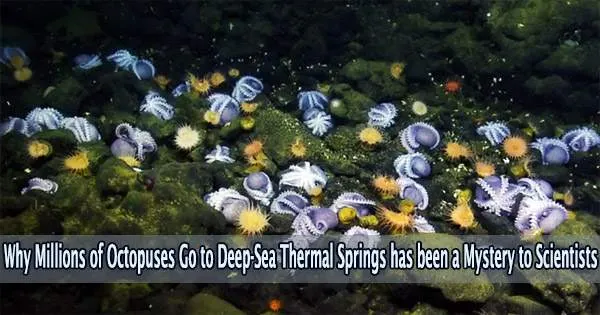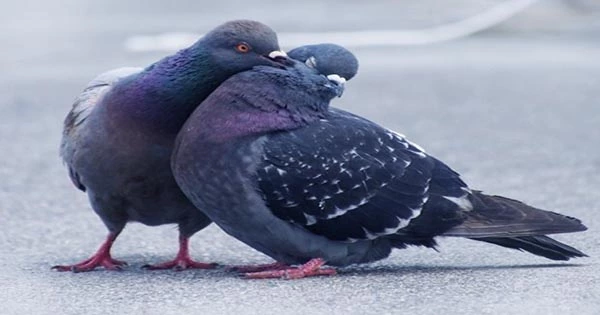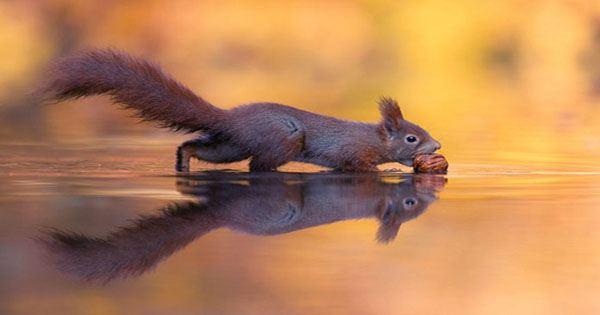In the year 2018, a team of researchers from the Monterey Bay National Marine Sanctuary of the National Oceanic and Atmospheric Administration (NOAA) and Nautilus Live conducted an observation of numerous octopuses nesting on the deep seafloor situated off the coast of Central California. The discovery of the “Octopus Garden” captured the curiosity of millions of people around the world, including Monterey Bay Aquarium Research Institute scientists.
For three years, MBARI and collaborators used high-tech tools to monitor the Octopus Garden and learn exactly why this site is so attractive for deep-sea octopus.
In a new study published in Science Advances, a team of researchers from MBARI, NOAA’s Monterey Bay National Marine Sanctuary, Moss Landing Marine Laboratories, the University of Alaska Fairbanks, the University of New Hampshire, and the Field Museum confirmed that deep-sea octopus migrate to the Octopus Garden to mate and nest.
The Octopus Garden is among a limited number of recognized deep-sea octopus breeding grounds. Within this facility, the thermal springs’ warmth expedites the maturation of octopus eggs. Researchers posit that the abbreviated gestation period heightens the likelihood of a juvenile octopus’ viability.
The Octopus Garden represents the most extensive conglomeration of octopus globally, with scientists having tallied over 6,000 octopus in a segment of the location and anticipating that the nursery may harbor 20,000 or more.
“Thanks to MBARI’s advanced marine technology and our partnership with other local researchers, we were able to observe the Octopus Garden in tremendous detail, which helped us discover why so many deep-sea octopus gather there. These findings can help us understand and protect other unique deep-sea habitats from climate impacts and other threats,” said MBARI Senior Scientist Jim Barry, lead author of the new study.
The Octopus Garden is located 3,200 meters (10,500 feet, or about two miles) below the ocean’s surface on a small hill near the base of Davidson Seamount, an extinct underwater volcano 130 kilometers (80 miles) southwest of Monterey, California. The site is full of Muusoctopus robustus species MBARI researchers nicknamed the pearl octopus because from a distance, nesting individuals look like opalescent pearls on the seafloor.
During a series of 14 dives utilizing MBARI’s remotely operated vehicle (ROV) Doc Ricketts, the research team acquired knowledge regarding the rationale behind the substantial congregation of pearl octopus in this particular area. The existence of mature male and female octopus, embryonic eggs, and newly hatched octopus strongly suggests that this site is solely utilized for reproductive purposes. The team did not detect any specimens of intermediate size or any indications of feeding activity. Pearl octopus gather at this site solely to mate and nest.
When researchers from NOAA and Nautilus Live first discovered the Octopus Garden, they observed “shimmering” waters. The aforementioned occurrence transpires when warm and cool waters intermingle, indicating the presence of hitherto undiscovered thermal springs in the area.
Subsequent scrutiny conducted by researchers from MBARI and their associates substantiated that the nests of octopuses are concentrated in crevices that are immersed in hydrothermal springs, where warmer waters emanate from the seabed.
The ambient water temperature at 3,200 meters (10,500 feet) deep is 1.6° Celsius (about 35° Fahrenheit). However, the water temperature within the cracks and crevices at the Octopus Garden reaches nearly 11°C (about 51°F).
Octopuses are ectotherms, or cold-blooded animals. The frigid temperatures of the deep sea slow their metabolism as well as their rate of embryonic development. Most deep-sea octopuses have very long incubation periods compared to their relatives inhabiting warmer shallow seas.
Previous studies have conducted assessments on the duration of egg incubation for various octopus species in diverse habitats and geographical regions across the globe. A comparative analysis of these incubation periods unequivocally illustrates the impact of temperature on the pace of embryo development, whereby lower water temperatures result in a decelerated growth rate of the embryos.
The deep sea is one of the most challenging environments on Earth, yet animals have evolved clever ways to cope with frigid temperatures, perpetual darkness, and extreme pressure. Very long brooding periods increase the likelihood that a mother’s eggs won’t survive. By nesting at hydrothermal springs, octopus moms give their offspring a leg up.
Jim Barry
At the near-freezing temperatures of the abyss, researchers expected pearl octopus eggs to take five to eight years, if not longer, to hatch. A 4K camera on MBARI’s ROV Doc Ricketts provided a close-up look at nesting mothers.
The researchers from the Monterey Bay Aquarium Research Institute (MBARI) and their collaborators employed a method of monitoring the growth of octopus broods by observing the unique markings and other distinctive characteristics of individual octopus mothers. To their surprise, the eggs hatched in a period of less than two years. The heightened metabolic rate of female octopuses and their broods, brought about by the warmth emanating from thermal springs, was found to be the cause of this accelerated incubation process.
The researchers posit that the shorter brood period in warmer waters significantly reduces the likelihood of developing octopus embryos being subjected to harm or predation by predators. The act of nesting in warmer waters serves to enhance the reproductive success of the pearl octopus, thereby ensuring the survival of its offspring.
“The deep sea is one of the most challenging environments on Earth, yet animals have evolved clever ways to cope with frigid temperatures, perpetual darkness, and extreme pressure. Very long brooding periods increase the likelihood that a mother’s eggs won’t survive. By nesting at hydrothermal springs, octopus moms give their offspring a leg up,” said Barry.
The massive number of octopus in one area attracts both predators and scavengers. Like most other cephalopods, pearl octopus die after they reproduce. Dead octopus at the Octopus Garden provide a feast for scavengers. A rich community of invertebrates lives alongside the nesting females, undoubtedly benefiting from unhatched eggs, vulnerable hatchlings, or adult octopus that have died.
Davidson Seamount and its Octopus Garden are protected as part of Monterey Bay National Marine Sanctuary. Previous MBARI expeditions to Davidson Seamount in 2002 and 2006 revealed the stunning community of life on its rocky slopes.
MBARI’s images and video of beautiful deep-sea corals, vibrant sponges, and curious fishes engaged and inspired audiences worldwide. Ocean champions spoke up to protect this unique, and still untouched, ocean wilderness. In 2008, resource managers expanded the Monterey Bay National Marine Sanctuary to include Davidson Seamount.
“Essential biological hotspots like this deep-sea nursery need to be protected,” said Barry. “Climate change, fishing, and mining threaten the deep sea. Protecting the unique environments where deep-sea animals gather to feed or reproduce is critical, and MBARI’s research is providing the information that resource managers need for decision-making.”
History of discoveries at the Davidson Seamount
For more than two decades, researchers from MBARI and NOAA have collaborated to study Davidson Seamount. Since the first expedition to the seamount in 2002, NOAA has leveraged MBARI expertise in marine geology and benthic biology and ecology to develop a comprehensive research program that aims to understand the unique community of life on and around Davidson Seamount. Now, Davidson Seamount is considered one of the best-studied and well-protected seamounts in the world.
In October 2018, a team of researchers from NOAA, the Ocean Exploration Trust, and collaborators made an expedition to Davidson Seamount aboard the E/V Nautilus. At the suggestion of MBARI geologists and NOAA researchers, the Nautilus Live team decided to expand their exploration from the top of the seamount to its surrounding foothills. The researchers discovered thousands of octopus aggregated around a rocky ridge adjacent to the towering seamount.
Most of the octopus were oriented upside down, inverting their arms and folding them around their bodies. This posture was an indication of pearl octopus (Muusoctopus robustus) mothers protecting, or brooding, their eggs. The pearl octopus is a pale purple species about the size of a grapefruit that occurs in the northeastern Pacific Ocean from Oregon to Baja California. MBARI has observed this species at depths of 2,300 to 3,600 meters (7,500 to 11,800 feet).
MBARI researchers and their collaborators deployed a suite of advanced scientific instruments developed by MBARI engineers to better understand the Octopus Garden.
“The expertise of the MBARI team the engineers, pilots of our submersible vehicles, and crew of our research vessels was integral to studying this hotspot of life two miles below the surface. We leveraged decades of experience in deep-sea exploration to develop and deploy instruments to study the Octopus Garden without disturbing the nesting mothers,” said Barry.
MBARI’s ROV Doc Ricketts recorded high-definition and 4K video of the brooding pearl octopus and their neighbors. The proficient submersible pilots of MBARI deftly navigated the ROV in proximity to the brooding pearl octopus for the purpose of deploying instruments to gauge the environmental parameters within their nests, such as temperature and oxygen levels. Additionally, they captured footage of the mothers and their eggs in ultra-high definition resolution.
A stereoscopic camera allowed MBARI engineers to visualize sites within the Octopus Garden in 3D. The team also launched one of MBARI’s autonomous underwater vehicles to map the Octopus Garden at meter-scale resolution.
MBARI engineers outfitted the ROV Doc Ricketts with an innovative, custom-built sensor suite, the Low-Altitude Survey System (LASS), to see the Octopus Garden in even greater detail.
The LASS gathered detailed bathymetry information to help researchers characterize the seafloor habitat at centimeter-scale resolution. The LASS also took high-resolution photographs of the Octopus Garden.
Researchers assembled these photographs into a photomosaic to count the number of nests within this deep-sea nursery. They documented 5,718 octopus within a 2.5-hectare (6.2-acre) area at the center of the Octopus Garden. The team estimated the total population of the 333-hectare (823-acre) hillock could easily exceed 20,000 individuals.
Over a span of more than six months, a time-lapse camera was utilized to gather prolonged observations of the behavior of the octopus and alterations in the community. This enabled researchers to monitor the octopus nursery in between research expeditions. The camera recorded an image every 20 minutes and amassed a trove of more than 12,200 images from March 2022 to August 2022. These photographs revealed various activities and behaviors of octopus, their predators, and local scavengers.
Both male and female pearl octopus migrate to the Octopus Garden. Females search for a warm nesting spot to deposit a clutch of approximately 60 elongate, sausage-shaped eggs. When brooding, mothers cover their eggs with their body and protect them from predators that creep too close. She lives off food reserves from her own tissues while tending to her developing eggs.
The transformation from egg to hatchling is not easy. Furthermore, apart from successfully undergoing development, embryos must also evade harm, predation, infection, and other forms of external mortality. Maternal care serves as a safeguard against most external hazards, but a reduced brooding period typically results in a higher survival rate of eggs.
As is customary among cephalopods, both male and female pearl octopuses meet their demise subsequent to reproduction, with the Octopus Garden serving as their ultimate resting place. Most females live until their eggs have hatched. Sometimes, however, a mother octopus runs out of energy and dies before her eggs complete their development, exposing the developing eggs to greater risk.
The time-lapse camera revealed that nesting mothers push aside the carcasses of dead octopus. Food is scarce in the deep sea and nothing goes to waste. Larger scavengers like rattail fishes (family Macrouridae), cusk eels (family Ophidiidae), whelks, and sea anemones feast on octopus remains.
Near Davidson Seamount, life on the deep seafloor depends on the rain of organic matter from above. Researchers estimated the turnover of male octopus and nesting females to calculate how much nutrition this massive aggregation provides. Biomass from dying octopus represents a substantial carbon subsidy to the local seafloor community, providing 72% more food than is available outside the Octopus Garden.
Numerous inquiries persist regarding the Octopus Garden, encompassing the whereabouts of pearl octopus post-hatching, the evolutionary process that facilitated the adaptation of this octopus species to procreate in thermal springs, the mechanism by which adult octopus locate the thermal springs, the comparative advantages of individuals breeding in these hydrothermal springs over those breeding elsewhere, and the prevalence of hydrothermal springs in the abyssal depths.
The deep sea is not immune to threats like fishing, pollution, and climate change. By documenting deep-sea biodiversity and identifying hotspots of life on the ocean floor, scientists are gathering important information that resource managers can use to guide protections for this unique environment and its inhabitants.
“Technological advances in our ability to study the ocean have helped us discover and document incredible biodiversity across an array of deep-sea environments. As the imprint of human activities reaches deeper into ocean ecosystems, we need to protect not only the octopus nurseries found off California and Costa Rica, but also the many other biological treasures that remain undiscovered,” emphasized Barry.
Deep-sea octopus nurseries: A new field of exploration
Researchers have documented four deep-sea octopus nurseries to date two off the coast of Central California and two off the coast of Costa Rica and are continuing to study these sites to learn more about octopus behavior:
Dorado Outcrop (Costa Rica)
Researchers from the University of Akron, the Field Museum, and the University of Alaska Fairbanks observed an aggregation of more than 100 octopus at the Dorado Outcrop, a hydrothermal spring located approximately 160 kilometers (100 miles) off the Pacific coast of Costa Rica at a depth of 3,000 meters (9,800 feet).This was the first discovery of an octopus nursery in December 2013.
The team identified the octopus as a potentially undescribed species of Muusoctopus. Nearly all of the individuals were in a brooding position, however, none of the eggs that researchers observed were viable.
The team of researchers from the University of Akron, the Field Museum, and the University of Alaska Fairbanks published their observations of deep-sea octopus brooding unviable eggs at theDorado Outcrop in Deep Sea Research Part Iin April 2018.
Octopus Garden (Davidson Seamount, US)
During a Nautilus Live expedition with the E/V Nautilus, in October 2018,researchers from NOAA’s Monterey Bay National Marine Sanctuary, the Ocean Exploration Trust, and collaborators observed a large aggregation of brooding octopus on a hillock approximately 12 kilometers (7.5 miles) southeast of Davidson Seamount at a depth of 3,200 meters (10,500 feet). Researchers identified the octopus as Muusoctopus robustus.
A second visit by researchers from NOAA and the Woods Hole Oceanographic Institution (WHOI) in March 2019 confirmed the presence of warm hydrothermal springs at this site. The expedition team also confirmed that the octopus were brooding viable eggs and observed baby octopus hatching from the eggs, thus it was deemed the second known octopus nursery.
MBARI researchers made their first visit to the Octopus Garden as part of the 2019 Seafloor Ecology expedition. Along with collaborators, they visited the site 14 times with the R/V Western Flyer between April 2019 and August 2022. Additionally, MBARI researchers visited the Octopus Garden with the R/V Rachel Carson in February 2022 to launch a mapping autonomous underwater vehicle and create meter-scale maps of the site.
Octocone (Davidson Seamount, US)
During a Nautilus Live expedition with the E/V Nautilus, researchers from NOAA, the Ocean Exploration Trust, and collaborators observed a second aggregation of brooding octopus on a volcanic cone to the east of Davidson Seamount, the third identified octopus nursery. This site is approximately 17 kilometers (10.5 miles) northeast of the Octopus Garden. Researchers identified the octopus as Muusoctopus robustus. The octopus were confirmed to be brooding viable eggs.
As-yet unnamed seamount (Costa Rica)
During a Schmidt Ocean Institute expedition in June 2023with the R/V Falkor (too), researchers from the Bigelow Laboratory for Ocean Sciences and the University of Costa Rica observed a previously unknown octopus nursery near an unexplored and still-unnamed seamount off the Pacific coast of Costa Rica.
Upon their return to the nearby Dorado Outcrop, the team also made an observation of octopuses brooding viable eggs, thereby confirming the fact that this location is, in fact, an active octopus nursery. Both Costa Rican nurseries host a potentially undescribed species of Muusoctopus.
















